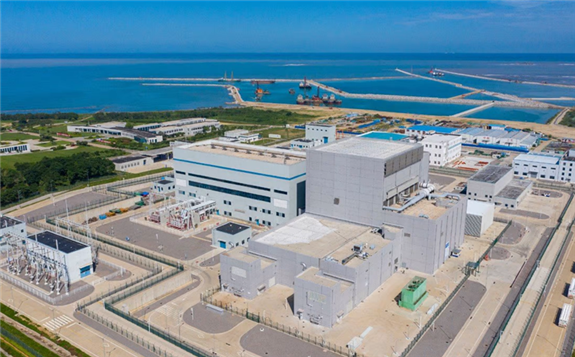The first unit of China’s fourth-generation nuclear reactor has been connected to the national power grid – with two more to follow.
 A view of the Shidaowan nuclear power station in Shandong province. Photo: Weibo
A view of the Shidaowan nuclear power station in Shandong province. Photo: Weibo
The domestically developed high-temperature gas-cooled reactor (HTGR) – at the Shidaowan nuclear power plant in China’s eastern Shandong province – is currently the world’s only one in commercial operation.Jointly built by state-owned power giant China Huaneng Group, China National Nuclear Corporation (CNNC) and Beijing’s Tsinghua University, the reactor is made up of two small units with a total generation capacity of 200 megawatts (MW).The second unit is still under construction and expected to begin commercial operations in mid-2022, according to China Huaneng Group.The commissioning of the reactor on Monday shows that “China has become one of the few countries in the world to master the fourth-generation nuclear technology and is a world leader in nuclear power technology”, CNNC said on its website.China is among countries that see nuclear technology as one way to decarbonise the energy sector. It had about 50 gigawatts (GW) of installed nuclear capacity at the end of last year, with another 18.5GW under construction.
Last year, China surpassed France in nuclear energy generation for the first time, to take the No 2 spot behind the United States, according to the World Nuclear Industry Status Report.Construction of the two HTGR units at Shidaowan began in 2012. They were expected to be ready in about five years, but faced delays due to design and manufacturing problems.CNNC said it was steadily promoting China’s next, larger-scale HTGR project.
A tender notice on the company’s website in October revealed that two HTGRs were due to begin construction next year at the Xinan nuclear power plant in Shandong.
Four Hualong One reactors, featuring Chinese-developed third-generation technology, will also be built at the same plant.The first phase of the project, with two 600MW HTGRs, is expected to start construction in February, with the first unit due to be fired up in 2026.
The HTGR at Shidaowan used fully home-grown technology, and nearly 94 per cent of the equipment used was locally sourced, CNNC said.Its core design ensures that the reactor will run safely at high temperatures and also eliminates the possibility of a core meltdown, the statement on its website said.
The reactor’s high temperature can have many other applications, including ethanol purification, and the production of petrochemicals, coal chemicals and hydrogen.However, the previous four HTGRs in operation – two each in the United States and Germany – had to be shut down some four decades ago after experiencing problems including helium leaks, fuel failure and water ingress.